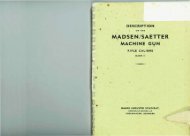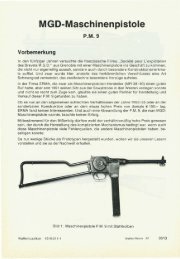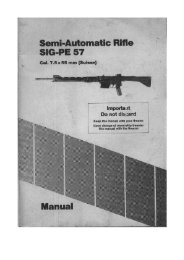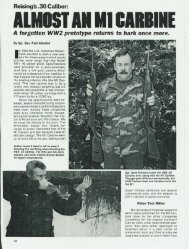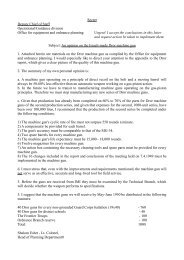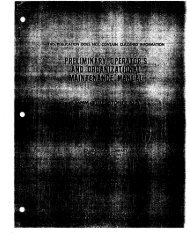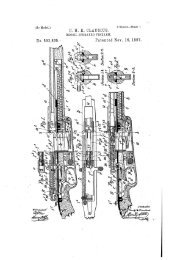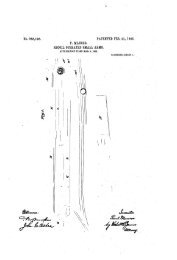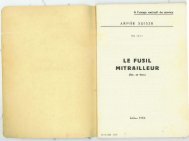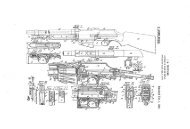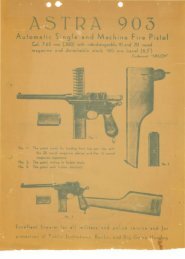Ross Rifle 1907 Manual.pdf - Replica Plans and Blueprints
Ross Rifle 1907 Manual.pdf - Replica Plans and Blueprints
Ross Rifle 1907 Manual.pdf - Replica Plans and Blueprints
Create successful ePaper yourself
Turn your PDF publications into a flip-book with our unique Google optimized e-Paper software.
ROSS RIFLE<br />
HANDBOOK<br />
<strong>1907</strong><br />
OTI'AWA<br />
GovERNMENT PRINTING BuREAU<br />
2686 <strong>1907</strong>
4<br />
NAMES OF THE PARTS OF ROSS RIFLE, MARK 1.<br />
B<strong>and</strong>, fron t.<br />
Ban d, rear.<br />
Barrel.<br />
Bolt.<br />
Base sight, rear.<br />
Bushing, front.<br />
Bushing, rear.<br />
Catch, safety.<br />
Clamps, slide sight (2).<br />
Collar, windgauge.<br />
Cover, dust.<br />
Cover, sleeve bolt.<br />
Cut-off.<br />
E jector.<br />
Extractor.<br />
Guard h<strong>and</strong>, front.<br />
Guard h<strong>and</strong>, rear.<br />
Guard, trigger.<br />
Hood, sight, front.<br />
Knob, catch, safety.<br />
Leaf, sight, rear.<br />
Lifter.<br />
Link strap, rear.<br />
Link strap.<br />
Magazine.<br />
N ut, clamp stock.<br />
Nut, firing pin.<br />
Nut bearing, lifter.<br />
Pawl.<br />
P iece, cocking.<br />
P iece, finger, lifter.<br />
Pin, base sight, rear.<br />
Pin, axis, sight.<br />
Pin ejector.<br />
Pin , link strap.<br />
Pin, sear.<br />
Pin , firing.<br />
Pin, sleeve sight, front.<br />
Pin , slide sight (2)<br />
Pin , trigger.<br />
Plate, butt.<br />
P latform.<br />
P lunger, catch, safety.<br />
Receiver.<br />
R etainer, spring, main.<br />
Retainer, cut-off.<br />
Rivets, finger (2) .<br />
Rivets, guard h<strong>and</strong>, rear (2).<br />
Rivets, platform (2).<br />
Rivet, magazine.<br />
Screws, b<strong>and</strong> (2).<br />
Screw, bearing, lifter.<br />
Screw, cover.<br />
Screw, clamp, sight, front.<br />
Screw, clamp, stock.<br />
Screws, front, receiver (2).<br />
Screws, hood, sight (4).<br />
Screw, link, strap.<br />
Screws, p late, butt (2).<br />
Screw, rear, receiver.<br />
Screw, retainer, cut-off.<br />
Screw, windgauge.<br />
Sear.<br />
Sight, front.<br />
Sleeve, bolt.<br />
Sleeve, sight, front.<br />
Slide, index right.<br />
Slide, index, left.<br />
Slide, sight.<br />
Spring, clamp slide, sight.<br />
Spring, cut-off.<br />
Spring, plunger, catch, safety.<br />
Spring, ejector.<br />
Spring, guard h<strong>and</strong>, rear.<br />
Spring, leaf, sight.<br />
Spring, lifter.<br />
Spring, main.<br />
Spring, pawl.<br />
Spring, piece cocking.<br />
Spring, retainer cut-off.<br />
Spring, stop bolt.<br />
Spring, trigger.<br />
Spring, butt trap.<br />
Stock.<br />
Stop bolt.<br />
Swivel piling.<br />
Thimble m icrometer.<br />
T rigger.<br />
Trap butt.<br />
Washer, piece cocking.<br />
Washer, stock.<br />
W indgauge.<br />
TO STRIP THE ROSS RIFLE MARK J.<br />
NOTE.-Such terms as right, left, top, bottom, front, rear, etc., are<br />
assuming the rifle to be in the normal firing position.<br />
1. Remove the bolt.<br />
2. Take out the strap link screw.<br />
3. Unscrew the four screws <strong>and</strong> remove the front sight hood.<br />
4. Unscrew the front sight clamp screw <strong>and</strong> remove the front sight.<br />
5. Take out the front b<strong>and</strong> screw <strong>and</strong> tap off the front b<strong>and</strong>.<br />
6. Take out the rear b<strong>and</strong> screw <strong>and</strong> slip forward the front h<strong>and</strong>guard<br />
until the rear b<strong>and</strong> can be removed.<br />
7. Remove the front h<strong>and</strong>guard.<br />
8. Push forward the sight slide <strong>and</strong> remove the rear h<strong>and</strong> guard levering<br />
it up from the rear end.<br />
9. Remove the dust cover by inserting a dummy cartridge or punch<br />
<strong>and</strong> springing the front end out of its recess when it can be slid forward<br />
<strong>and</strong> removed.<br />
10. Remove the receiver rear screw <strong>and</strong> front screws.<br />
11. Remove the barrel <strong>and</strong> receiver.<br />
12. Remove the bolt stop spring <strong>and</strong> bolt stop.<br />
13. Remove the trigger guard.<br />
14. Take out the front <strong>and</strong> rear bushings from the stock.<br />
15. Unscrew the lifter bearing nut <strong>and</strong> screw <strong>and</strong> remove the lifter <strong>and</strong><br />
lifter spring.<br />
16. Unscrew the stock clamp <strong>and</strong> nut.<br />
17. Unscrew the butt plate <strong>and</strong> remove the butt trap.<br />
18. Unscrew the butt trap spring screw <strong>and</strong> remove the butt trap spring<br />
from the butt plate. (This should not be removed except to replace a<br />
broken one.)<br />
19. Remove the cut off (or rear portion of the magazine) which is loose.<br />
20. Unscrew the cut off retainer screw from the trigger guard.<br />
21. Remove the cut off retainer, <strong>and</strong> cut off retainer spring (spiral).<br />
22. Drift the cut off spring (flat) to the rear out of its groove. (This<br />
should not be removed except to replace a broken spring.)<br />
23. Drive out the trigger pin from either side of the trigger guard.<br />
24. Drift forward the trigger spring. (This should not be removed<br />
except to replace a broken spring.)<br />
25. (a) Screw off the micrometer thimble.<br />
(b) Push forward <strong>and</strong> remove the index slides when the sight slide<br />
<strong>and</strong> its components will slip off.<br />
(c) Drive out the sight axis pin from either side <strong>and</strong> remove the<br />
sight leaf spring. (The sight slide pins are a driving fit <strong>and</strong><br />
must not be removed.)<br />
26. The windgauge collar is a driving fit <strong>and</strong> should only be removed<br />
when absolutely necessary to repair the windgauge.<br />
5
27. Unscrew the windgauge screw <strong>and</strong> slip off the windgauge.<br />
28. Drive out the sear pin from either side <strong>and</strong> remove the pawl (with<br />
pawl spring assembled) <strong>and</strong> sear.<br />
29. Slip out the pawl spring from its seating in the pawl.<br />
30. Raise the rear end of the ejector spring from its seating in the<br />
receiver <strong>and</strong> press forward the ejector until its slot is free from the ejector<br />
pin, when the ejector (with spring assembled) can be removed.<br />
31. The ejector spring should not be removed from the ejector except<br />
to replace a broken one.<br />
32. Unscrew the barrel.<br />
To STRIP THE BoLT OF MARK I RIFLE.<br />
33. Put the safety catch "off" by pressing it to the right.<br />
34. Pull the bolt head forward until the notches on the bolt <strong>and</strong> cocking<br />
piece are heard to engage.<br />
35. Turn the extractor until its lower edge is against the rib underneath<br />
the bolt sleeve when it can be prized off frontwards.<br />
36. Return the bolt head by pulling back the "bent" of the cocking<br />
piece with the flat of a screw driver or any convenient tool. (No attempt<br />
must be made to push or hammer back the bolt head itself.)<br />
37. Put the safety catch "on" by pressing it to the left.<br />
38. Pull back <strong>and</strong> unscrew the firing pin nut.<br />
39. Put the safety catch "off" by pressing it to the right.<br />
40. Slip off the cocking piece, cocking piece spring, <strong>and</strong> cocking piece<br />
washer.<br />
41. Remove the bolt from the bolt sleeve.<br />
42. Place the mouth of an empty cartridge case over the firing pin <strong>and</strong><br />
press forward until the stud on the retainer is forced out of the slot in<br />
the bolt-give it a right h<strong>and</strong>ed turn until the same stud is opposite the<br />
groove in the bolt spiral when the weight of the main-spring will force the<br />
retainer off the bolt-(care must be taken not to lose the retainer by the<br />
sudden releasing of the mainspring). The mainspring <strong>and</strong> firing pin can<br />
now be removed.<br />
43. Remove the safety catch by pressing it to the left.<br />
44. Remove the safety catch spring <strong>and</strong> plunger from the bolt sleeve.<br />
45. Unscrew the cover screw <strong>and</strong> prize off the bolt sleeve cover. This<br />
is a driving fit <strong>and</strong> should not be removed except to replace a broken<br />
part.<br />
TO ASSEMBLE THE ROSS RIFLE, MARK I.<br />
1. Screw the barrel to the receiver.<br />
2. Assemble the stock clamp screw <strong>and</strong> nut from either side.<br />
3. Screw the butt trap spring into the butt plate <strong>and</strong> insert the butt<br />
trap.<br />
(Knob of trap to be towards toe of butt plate.)<br />
4. Screw on the butt plate.<br />
5. (a) Put in the lifter.<br />
(b) Screw in the lifter bearing nut <strong>and</strong> screw from either side.<br />
(c) See that the lifter works freely.<br />
6. Put in the lifter spring 'vith its coil towards the muzzle <strong>and</strong> square<br />
end downwards.<br />
7<br />
7. See that the ejector spring is in the ejector <strong>and</strong> unbroken.<br />
8. See that the ejector is smooth <strong>and</strong> free from "burrs." .<br />
9; See that the ejector slot in the receiver is clean <strong>and</strong> the ejector pin<br />
smooth.<br />
10. Put the ejector (with spring assembled) into the ejector slot allowing<br />
the spring to pass to the rear (above the ejector pin) until its point<br />
engages the cross cut slot in the receiver at the same time guide the slot<br />
in the ejector over the ejector pin. See that the ejector works freely.<br />
11. Assemble the pawl to the sear (pawl to the front with spring seating<br />
underneath; long arm of the sear to the rear, short arm downwards).<br />
12. Insert the pawl spring (concave side outwards) with its wide end<br />
in the seating in the pawl <strong>and</strong> the narrow end resting against the front<br />
of the short arm of the sear.<br />
13. Holding with a drift the axis holes of the pawl <strong>and</strong> sear in line with<br />
those in the lugs underneath the receiver, insert the sear pin from either<br />
side.<br />
14. Assemble the trigger spring to the trigger guard (hole to the rear).<br />
Punch the metal of the trigger guard to secure the spring.<br />
15. Assemble the trigger to the trigger guard (finger grip to the rear<br />
<strong>and</strong> downwards) <strong>and</strong> insert the trigger pin from either side.<br />
16. Assemble the cut off spring (flat) to the trigger guard (hole to thE><br />
front). Punch the metal of the trigger guard to secUl'e the spring.<br />
17. Insert the cut off retainer (with catch upwards <strong>and</strong> to the front)<br />
behind the cut off spring.<br />
. 18. Insert the cut off retainer spring so that one end of it is in the seating<br />
m the back of the cut off retainer <strong>and</strong> the other end is in the seating in<br />
the slot of the trigger guard.<br />
19. Press down the cut off retainer until its axis hole is in position <strong>and</strong><br />
screw in the cut off retainer screw from the right of the trigger guard.<br />
20. Assemble the cut off (rear part of the magazine) to the trigger<br />
guard depressing it, until it is held firmly by the catch of the cut off<br />
retainer.<br />
21. Insert the front bushing from underneath the stock with its closed<br />
end downwards.<br />
22. Assemble the trigger guard with the cut off (rear part of the magazine)<br />
held by the cut off retainer, being careful that the magazine platform<br />
is not above the upper edges of magazine.<br />
23. Insert the rear bushing.<br />
24. Assemble the windgauge to the rear sight leaf.<br />
25. Insert the windgauge screw from left to right.<br />
26. Drive on the windgauge collar which is a driving fit.<br />
27. Assemble the sight slide clamp spring in the slot of the sight slide;<br />
points to be so arranged as to project into the notches of the sight slide<br />
clamps which fit one on each side of it; the milled grips of the clamps<br />
to be flush with the top <strong>and</strong> bottom of the sight slide. (The points of<br />
the spring must not protrude above the clamps or they will prevent free<br />
movement of the slide along the rear sight base.)<br />
28. Assemble the rear sight leaf <strong>and</strong> sight leaf spring to the rear sight<br />
base; (horns of the spring to rest on the barrel with their points towards<br />
the muzzle).<br />
29. Drive in the sight axis pin from either side.<br />
30. (a) Turn the rear sight leaf over on to its back.<br />
(b) Invert the sight slide <strong>and</strong> place it over the rear sight leaf just<br />
in front of the sight a:ris pin.
8<br />
(c) See that the sight slide pins are one below <strong>and</strong> one above the<br />
flanged edges of the rear sight leaf.<br />
(ti) When so inverted the bevelled edge of the sight slide should<br />
be towards the muzzle.<br />
(e) Turn the leaf <strong>and</strong> slide together on to the rear sight base.<br />
(f) Insert the index slides from the front, notches outwards; the<br />
slotted ends to be towards the muzzle, with the chamfering<br />
upwards.<br />
(g) Push the rear ends of the index slides into the slots on the sight<br />
slide.<br />
(h) Place the micrometer thimble over the index slides with the<br />
chamfered ends of the slides in the grooves across the thread<br />
of the rear sight base. Screw home the micrometer thimble<br />
until the 0 is on the cross line cut on the rear sight base.<br />
(k) Should the micrometer thimble work too loosely it can be<br />
tightened by removing it <strong>and</strong> exp<strong>and</strong>ing the screw part of<br />
the rear sight base which is slotted underneath for the<br />
purpose.<br />
NoTE.-Rear sight base <strong>and</strong> front sight sleeve are driven on <strong>and</strong> fixed<br />
with a pin. The barrel will, as a rule, be issued with these parts assembled.<br />
Should it, however, be necessary to replace them, they should be<br />
sheared off <strong>and</strong> the greatest care taken not to bend or dent the barrel when<br />
drilling the hole for the fixing pin.<br />
31. Insert the bolt stop spring in the bolt stop.<br />
32. Insert the bolt stop (with spring assembled) in the stock-thumb<br />
piece upwards-taking care that the spring drops correctly into its seating.<br />
33. Assemble the barrel <strong>and</strong> receiver to the stock.<br />
34. Insert the receiver rear screw <strong>and</strong> front screws (2).<br />
35. Assemble the dust cover (concave side upwards <strong>and</strong> hole towards<br />
muzzle). To do this enter its rear end in the grooves in the trigger guard<br />
pressing it backwards <strong>and</strong> upwards with a dummy cartridge inserted into<br />
the hole of the dust cover.<br />
36. Assemble the h<strong>and</strong> guards (front <strong>and</strong> rear) being careful that the<br />
recessed ends are properly fitted under the rear sight base.<br />
37. Assemble the rear b<strong>and</strong>, sliding forward the front h<strong>and</strong> guard until<br />
the b<strong>and</strong> is in its seating. Draw. back both together to their proper<br />
position <strong>and</strong> screw in the rear b<strong>and</strong> screw from the left.<br />
38. Assemble the front b<strong>and</strong> with piling swivel assembled, inserting<br />
the screw from the left.<br />
39. Assemble the front sight to the front sight sleeve. (Slope towards<br />
muzzle.)<br />
40. Screw in the front sight clamp screw.<br />
41. Screw the front sight hood to the front sight sleeve. (Slope towards<br />
muzzle.<br />
42. Screw the strap link screw with strap link assembled into the butt.<br />
To Assm.mLE THE BoLT OF MARK I RIFLE.<br />
43. Drive on the bolt sleeve cover from front to rear <strong>and</strong> screw in the<br />
cover screw.<br />
44. Assemble the safety catch spring <strong>and</strong> safety catch plunger to the<br />
bolt sleeve (point of plunger to the rear).<br />
45. Insert the safety catch from the left.<br />
9<br />
46. Press in the plunger until the safety catch has ridden over it <strong>and</strong><br />
the notches engage its point correctly both at "on" <strong>and</strong> "off" positions.<br />
When correctly assembled the milled grip of the safety catch will be to<br />
the right.<br />
47. Insert the firing pin into the bolt.<br />
48. Insert the main spring.<br />
49. Insert the retainer with milled edge outwards.<br />
50. Using an empty cartridge case press home the retainer guiding the<br />
stud on its surface into the groove in the bolt spiral.<br />
51. As soon as the stud can be seen through the slot in the bolt turn<br />
the retainer to the left until the stud is held in its recess under the action<br />
of the mainspring.<br />
52. Enter the bolt in the bolt sleeve so that when pushed home the<br />
ejector slot in the bolt head is underneath.<br />
53. Place the cocking piece washer over the firing pin.<br />
54. Place the cocking piece spring over the firing pin (this spring must<br />
always be in the rear of the cocking piece washer <strong>and</strong> it is most important<br />
that neither the spring nor washer should be omitted).<br />
55. Turn the firing pin so that its flats are vertical.<br />
56. Place the cocking piece over the firing pin, cocking piece spring<br />
<strong>and</strong> cocking piece washer; (with its "bent" in the slot underneath the<br />
bolt sleeve.)<br />
57. Place the safety catch to "on" by pressing it to the left.<br />
58. Screw on the firing pin nut until the stud on the rear face of the<br />
cocking piece engages firmly one of the notches in the front face of the<br />
firing pin nut.<br />
59. Release the safety catch.<br />
60. Pull the bolt head forward until the notches on the cocking piece<br />
<strong>and</strong> bolt are heard to engage. If the firing pin nut is properly screwed<br />
home the point of the firing pin should not protrude from the face of the<br />
bolt head when in this position.<br />
61. Insert the extractor between the bolt sleeve <strong>and</strong> bolt sleeve cover.<br />
62. Insert the bolt, pressing down the bolt stop until the lug on the<br />
bolt sleeve has passed it.<br />
63. See that the "bent" of the cocking piece is "caromed" back clear<br />
of the sear when the safety catch is placed at safety.<br />
64. Test the free action of the main spring.<br />
65. Pull off 4 to 7 lbs.<br />
NOTES ON MARK I BOLT.<br />
1. It is important to see the cocking piece spring assembled before<br />
putting on the firing pin nut-in order to take up back lash <strong>and</strong> prevent<br />
the firing pin nut becoming unscrewed.<br />
2. Be sure that the firing pin nut is screwed entirely home so that the<br />
ribs on the rear of the cocking piece firmly engage the notches in the<br />
front of the fi1-ing pin nut.<br />
3. If the cocking piece washer or cocking piece spring is left out, the<br />
firing pin nut can be so far screwed home that the point of the firing pin<br />
will not strike the cap of the cartridge <strong>and</strong> ami s fire will be the result.<br />
4. When the bolt is properly assembled to the bolt sleeve the ejector<br />
slot in the bolt head should lie underneath, assuming the bolt to be in<br />
the firing position.<br />
26 6-2
10<br />
5. The retainer should be inserted with its milled edge outwards <strong>and</strong><br />
care must be taken that the nib on the retainer is carried over the shoulder<br />
in the bolt <strong>and</strong> down into its slot.<br />
6. It will be found advantageous to press down on the firing pin nut<br />
with the thumb of the right h<strong>and</strong> in order to lessen the friction when<br />
pressing the safety catch to the left to put it "on."<br />
KAllillS OF THE PARTS OF ROSS RIFLE, MARK II.<br />
B<strong>and</strong>, front.<br />
B<strong>and</strong>, rear.<br />
Barrel.<br />
Holt.<br />
Base sight, rear.<br />
Catch, safety.<br />
Clamps, slide, sight (2).<br />
Collar, windgauge.<br />
Cover. dust.<br />
Cut-off.<br />
E jector.<br />
Extractor.<br />
Guard, h<strong>and</strong>, front.<br />
Guard, h<strong>and</strong>, rear.<br />
Guard, trigger.<br />
Hood, sight, front.<br />
Knob catch, safety.<br />
Leaf, sight, rear.<br />
Lifter.<br />
L ink, strap, rear.<br />
Link, strap.<br />
Magazine.<br />
)!ut, clamp, stock.<br />
rut, bearing, lifter.<br />
Pawl.<br />
Piece, cocking.<br />
Piece, finger, lifter.<br />
Pin, base, sight, rear.<br />
Pin, axis, sight.<br />
Pin, cam.<br />
Pin, ejector.<br />
Pin, link strap (2).<br />
Pin, sear.<br />
Pin, firing.<br />
Pin, sleeve, sight, front.<br />
Pin, slide, sight (2).<br />
Pin, trigger.<br />
Plate, butt.<br />
Platform.<br />
Plunger, catch, safety.<br />
Plunger, piece, cocking.<br />
Receiver.<br />
Retainer, spring, main.<br />
Rivets, finger (2).<br />
Rivets, guard, h<strong>and</strong>, rear (2).<br />
Rivets, platform (2).<br />
Screws, b<strong>and</strong> (2).<br />
Screw, bearing, lifter.<br />
Screw, clamp, sight, front.<br />
Screw, clamp, stock.<br />
Screws, front, receiver (2).<br />
Screws, hood, sight ( 4).<br />
Screw, locking, barrel.<br />
Screw, link, strap.<br />
Screws, magazine (2).<br />
Screws, plate, butt (2).<br />
Screw, rear, receiver.<br />
Screw, windgauge.<br />
Sear.<br />
Sight, front.<br />
Sleeve, bolt.<br />
Sleeve, sight, front.<br />
Slide, index, right.<br />
Slide, index, left.<br />
Slide, sight.<br />
Spring, clamp, slide, sight.<br />
Spring, cut-off.<br />
Spring, plunger, catch, safety.<br />
Spring, ejector.<br />
Spring, guard, h<strong>and</strong>, rear.<br />
Spring, leaf, sight.<br />
Spring, lifter.<br />
Spring, main.<br />
Spring, pawl.<br />
Spring, sear.<br />
Spring, stop bolt.<br />
Spring, trap, butt.<br />
Stock.<br />
Stud, link, strap.<br />
Stop, bolt.<br />
Swivel piling.<br />
Thimble, micrometer.<br />
Trigger.<br />
Trap butt.<br />
Washer, pin firing.<br />
Washer, stock.<br />
'\Vindgauge.<br />
DESCRIPTION OF ROSS RIFLE, MARK II.<br />
BarreL-The barrel screws into the receiver with 1! turns of a very<br />
coarse left h<strong>and</strong>ed thread <strong>and</strong> is secured by a locking screw which passes<br />
through the receiver into a slot cut in the thread of the barrel. The sights,<br />
front <strong>and</strong> rear, are mounted on sleeves which are driven on <strong>and</strong> pinned<br />
to the top of the barrel by a parallel pin.<br />
The rifling which is of the concentric type consists of four grooves<br />
ha,·ing a right h<strong>and</strong>ed twist of 1 turn in 10 inches.<br />
Sighls.-The front sight is a barleycorn which is dovetailed into the<br />
front sight sleeve <strong>and</strong> secured by a clamping screw. It is protected by a<br />
hood screwed to the sleeve.<br />
11<br />
The sleeve which connects the rear sight to the barrel is called the<br />
Rear Sight Base. Its top surface is flat <strong>and</strong> is graduated from 100 to<br />
2,200 yards, each range having a line drawn through the figures to indicate<br />
the correct "setting" of the sight for that range. The sides of the<br />
rear sight base are grooved to receive moveable racks called index slides,<br />
the notches of which engage the clamps of the slide by which the sight is<br />
fixed.<br />
The front end of the rear sight base is threaded to engage a ring for<br />
fine adjustment. Both its front <strong>and</strong> rear ends project over the barrel in<br />
such a manner that they secure the h<strong>and</strong>guards. Fine adjustment is<br />
obtained by the ring already mentioned which is termed the "micrometer<br />
thimble." It engages the front ends of the index slides <strong>and</strong> when revolved<br />
gives them a forward or backward movement carrying with them the<br />
sight slide <strong>and</strong> raising or lowering the rear sight leaf. It is graduated in<br />
tens from 0 to 100, the even numbers being marked in plain figures <strong>and</strong><br />
the odd numbers being indieated by a line.<br />
These graduations represent a horizontal increase or decrease of ten<br />
yards at any range, the curve of the sight leaf giving the extra height of<br />
backsight required.* The micrometer is at zero when the 0 rests on the<br />
cross line cut on the rear sight base from which position an increase or<br />
decrease of 50 yards range can be given.<br />
The value of each graduation on a vertical target is roughly 1 inch per<br />
100 yards.<br />
The male thread on the rear sight base is slit crossways underneath to<br />
allow the natural spring of the metal to take up any looseness from wear.<br />
The sight slide moves horizontally along the rear sight base. It contains<br />
two clamps which actuated by a V spring engage the notches of the<br />
index slides. From its upper surface two horns project, each containing<br />
a pin driven in <strong>and</strong> not meant to be removed. These pins are so arranged<br />
as to engage one above <strong>and</strong> one below the flange of the rear sight leaf.<br />
The rear sight leaf is of sheet steel pressed into a U section. It is<br />
curved to give the necessary changes of elevation, <strong>and</strong> its lower edges are<br />
flanged to engage the pins of the sight slide. It is hinged to the rear<br />
sight base at the front end by an axis pin which also keeps in place the<br />
sight leaf spring. This spring is formed like a saddle spring <strong>and</strong> keeps<br />
the rear sight leaf pressed against the upper pin of the sight slide.<br />
The rear end of the rear sight leaf is bent round to form a female<br />
thread for the windgauge screw which secures the windgauge to it.<br />
The windgauge works transversely across the rear sight leaf by the<br />
windgauge screw. Its rear edge has a 110e V notch cut in it. Lines for<br />
wind allowance are marked on ii:s upper _surface, each graduation giving<br />
roughly 4" per 100 yards. It is read by a centre line on the rear sight<br />
leaf.<br />
(In the latter issues of Mark II <strong>Rifle</strong>s this line may sometimes be found<br />
placed slightly to the right to counteract the "throw" of the rifle.)<br />
To adjust the sight: Presuming the micrometer thimble to be at zero,<br />
press inwards, with the thumb <strong>and</strong> finger, the milled heads of the sight<br />
*This method of adjustment was adopted in order to lessen the number<br />
of shots frequently wasted by the firer in picking up the correct elevation for<br />
different ranges, e.g.: A soldier at target practice on any particular day finds<br />
that at 500 yards he requires 520 yards elevation. When he moves to 800, he<br />
would easily remember to put on 820 yards <strong>and</strong> be far nearer the correct elevation<br />
for that day than if he endeavoured to work out for himself a proportionate<br />
increase.<br />
2868-2!
14<br />
A hole is drilled right through its left side into the screw thread <strong>and</strong> a<br />
small hardened, pointed pin, called the cock-ing piece plunger, is inserted<br />
in this bole wluch is afterwards slighlly closed with a l1ammer to prevent<br />
the plunger from falling out. It cannot fall inwards as the bole is drilled<br />
slightly off centre to the thread which accordingly forms a shoulder for it.<br />
When the bolt is assembled, tbis plunger engages one of the flats on<br />
the firing pin to prevent it from turning <strong>and</strong> is itself prevented from<br />
coming out by contact with the inner surface of the bolt sleeve, its point<br />
being rounded off to prevent friction or burrs.<br />
F'rom the underneath side of the cocking piece a rib projects wbich<br />
travels along the slot in the bolt sleeve <strong>and</strong> keeps the cocking piece from<br />
turning, <strong>and</strong> on this rib is a "bent" wbich is engaged by the nose of the<br />
sear to hold back the cocking piece <strong>and</strong> firing pin at full cock.<br />
Safety Catch.-The safety catch consists of a bolt into wbich is driven<br />
a pin having a milled knob. A vertical hole is drilled in wbich a punch<br />
can be inserted to depress lhe safety catch plunger spring when removing<br />
the safety catch.<br />
On the under side is a flat in wbich are cut transversely two grooves.<br />
The safety catch plunger actuated by its spring engages these grooves to<br />
prevent the accidental slipping of the safety catch from the "locked" <strong>and</strong><br />
"unlocked" positions respectively.<br />
On the rear surface is a cam which engages the front cut of the cocking<br />
piece already mentioned <strong>and</strong> withdraws the "bent" from the nose of the<br />
sear when the action is placed at "safety."<br />
The right end of the safety catch is cut at an angle to come flush with<br />
the bolt sleeve when assembled, <strong>and</strong> the left end acts as a locking bolt, a<br />
flat being cut to engage against a corresponding flat on the left side of<br />
the receiver <strong>and</strong> so prevent the opening of the bolt when set at "safety."<br />
Ejector.-The ejector is a flat piece of steel which works in a slot on<br />
the left side of the receiver, being held by a pin <strong>and</strong> actuated by a spring<br />
wbich presses its point inwards towards the bolt. Its right side is shaped<br />
so that by contact with the cam in the left side of the bolt it is withdrawn<br />
when the rifle is being loaded hut its pointed front end is allowed to intercept<br />
<strong>and</strong> eject the empty case when the bolt is withdrawn.<br />
Extractor.-The extractor is of sheet steel with a claw at its front end,<br />
<strong>and</strong> a lug on its underside wbich engages the rear edge of the bolt head<br />
<strong>and</strong> takes the resistance during extraction. Tbis lug also prevents the<br />
extractor from dropping out when the bolt is not in the rifle.<br />
Towards its rear end is n slot wbich can be used in case of necessity<br />
to hold the firing pin by its flats when stripping or assembling the bolt.<br />
It is secured to the bolt sleeve by fitting into two undercut grooves on<br />
its upper surface <strong>and</strong> is so placed that it wi!J prevent the bolt bead from<br />
turning beyond its pathway when the bolt lugs are unlocked. The front<br />
of the hook is rounded to let the natural spring of the extractor carry it<br />
over the rim of the cartridge on closing the bolt.<br />
Sear.-The sear is a triangular piece of steel of U section which fits<br />
inside the pawl to which it is attached by the sear pin. It is drilled to<br />
take the trigger pin wl1ich connects the trigger to it <strong>and</strong> is slotted <strong>and</strong><br />
15<br />
recessed for the sear spring <strong>and</strong> pawl spring which control its action in<br />
connection with the pawl <strong>and</strong> receiver.<br />
Its rear angle forms the "nose" to take the "bent" of the cocking<br />
piece.<br />
Pawl.-The pawl is also a triangular piece of steel of U section drilled<br />
to take the sear pin <strong>and</strong> reces ed <strong>and</strong> grooved to form a seating for the<br />
pawl spring.<br />
Trigger.-The trigger is in the form of a bent lever with an a.-cis hole<br />
at its bend. Its long arm is curved to form a finger grip <strong>and</strong> its short<br />
arm projects to the rear <strong>and</strong> bears against the bottom of the receiver to<br />
le,·er the sear from the cocking piece when trigger is pressed.<br />
Magazine.-The magazine is a vertical box entirely enclosed by the<br />
stock <strong>and</strong> fastened to the trigger guard by two screws on its underside.<br />
The front end is left open for the up <strong>and</strong> down movement of the lifter.<br />
It contains five cartridges. Its rear end is brazed for strength <strong>and</strong> has<br />
two slots on top to form guides for the horns of the cut off.<br />
Lifter.-Tbe lifter is a long steel bar having the magazine platform<br />
rivetted on to its rear end <strong>and</strong> working inside the magazine. It is situated<br />
below the barrel in the stock to which it is pivotted at its front end by a<br />
nut <strong>and</strong> screw.<br />
About half way along it the lifter finger piece is rivetted which projecting<br />
from the right side of the stock forms a grip for the left h<strong>and</strong> to<br />
work it up <strong>and</strong> down against a spring on the controllable platform principle.<br />
Cut Off.-The cut off is a sheet steel stem passing bebind the magazine<br />
<strong>and</strong> through a hole in the top of the trigger guard. It is curved at its<br />
lower eJo.-tremity to form a hook for the thumb.<br />
It has two projections pressed out respectively to the front <strong>and</strong> rear of<br />
the stem.<br />
The front one forms a "bent" wbich engaging a slot in the front of<br />
the trigger guard holds it in its downward or "on" position. The rear<br />
one forms a seating for the cut off spring whose upper end has a point<br />
wbich enters vertically into a small hole in tlus projection.<br />
The lower end of the cut off spring has a similar point wbich enters a<br />
similar hole in the top of the trigger guard.<br />
The top of the cut off is bent to the front to form two horns wbich lie<br />
0\"er the magazine platform <strong>and</strong> are kept in place by the slots in the rear<br />
end of the magazine in wbich they work.<br />
Bolt Stop.-The bolt stop is a pin wbich works vertically in a dovetailed<br />
seating on the left side of the receiver at its rear end. Its top is<br />
rounded <strong>and</strong> knurled to form a thumb grip. Its bottom end is recessed<br />
to receive the bolt slop spring which lies in the stock below it.<br />
Its right face projects through a slot in the receiver <strong>and</strong> intercepts the<br />
lug on the front end of the bolt sleeve until the bolt stop is pressed down<br />
to allow it to pass.
26<br />
moval of the pressure the sight leaf spring will reassert itself <strong>and</strong> bring<br />
the rear sight leaf back to its former position.<br />
At the rear end of the rear sight leaf is a wind gauge with a V notch cut<br />
on its upper edge <strong>and</strong> capable of lateral adjustment by means of a screw<br />
with a milled collar.<br />
A scale is marked on the rear sight leaf, each division of which represents<br />
roughly 4 inches per 100 yards.<br />
A thin wire spring is inserted under the curved rear end of the rear<br />
sight leaf with its point protruding through the right side so as to form a<br />
ratchet <strong>and</strong> engage a small recess in the left side of the milled collar.<br />
This can be both felt <strong>and</strong> heard to engage whenever the centre line of<br />
the wind gauge is opposite one of the marks on the scale. It also prevents<br />
the windgauge from slipping from the required position.<br />
To adju..st the sight.-Raise the sight slide by the finger grips until its<br />
teeth are released from the notches of the index slides. Push forward or<br />
draw back the sight slide until the numeral denoting the required range<br />
is wholly visible in rear of the finger grip, release the finger grip, when<br />
the teeth will engage the notches at the required range under the action<br />
of the index slide springs.<br />
To obtain fine adjmt1nrmt.-Revolve the micrometer thimble until the<br />
figm·e denoting the required-adjustment in yards is opposite the centre of<br />
the rear sight leaf.<br />
NoTE.-The fine adjustment is designed to give elevation only <strong>and</strong> not<br />
depression from the different hundred yard graduations on index slides.<br />
It will be noticed that when the micrometer thimble is revolved from left<br />
to right between 0 <strong>and</strong> 95 the index slides will advance, but if the revolution<br />
be continued from 95 to 0 the index slides will return to their normal<br />
position. Consequently if it be desired to give depression fr011L any<br />
hund1·ed yard range the sight must be set at the next lowest hundred yard<br />
range <strong>and</strong> elevation given by means of the micrometer thimble as required.<br />
When firing at 500 yards.<br />
To give 560 yards elevation, revolve the micrometer thimble from left<br />
to right until the figure 60 is opposite the centre of the rear sight leaf.<br />
To reduce this to 530 yards elevation revolve the micrometer thimble<br />
from right to left until the line representing 30 yards is opposite the centre<br />
of the rear sight leaf.<br />
To reduce this to 480 yards elevation, set the sight slide at 400 yards<br />
<strong>and</strong> revolve the micrometer thimble from left to right until the figure 80<br />
is opposite the centre of the rear sight leaf.<br />
To increase this to 500 yards, set the sight slide at 500 yards <strong>and</strong> revolve<br />
the micrometer thimble either way until the figure 0 is opposite the centre<br />
of the rear sight leaf.<br />
To STRIP THE MARK III. SIGHT.<br />
1. Set the sight at 1,000 yards with the micrometer thimble at zero<br />
<strong>and</strong> measure the height of the sight above the barrel. (See Para. 42 in<br />
Assembling the Mark III. sight.)<br />
27<br />
2. Set the sight to lowest range.<br />
3. Unscrew the set screw from micrometer thimble.<br />
4. Hold the micrometer cams from turning with a small screw driver<br />
or other pointed instrument inserted from the rear under the micrometer<br />
thimble into a notch cut for the purpose on the right micrometer cam<br />
<strong>and</strong> screw off the micrometer thimble.<br />
5. Loosen the screw in the sight leaf base.<br />
6. Drive the sight leaf base forward from the underside sufficiently to<br />
withdraw the index slides from the sight base ring.<br />
7. Raising the finger grips slip the sight slide off the rear ends of the<br />
index slides.<br />
8. Remove the index slides <strong>and</strong> index slide springs.<br />
9. Start the sight axis pin with a drift from the right side (about T 1 ll" of<br />
an inch).<br />
10. Using a screw driver or small pointed tool press the right coil of<br />
the sight leaf spring towards the right <strong>and</strong> out of the groove in the sight<br />
axis pin.<br />
11. Finish driving out the sight axis pin from the right.<br />
12. Remove the sight leaf <strong>and</strong> sight leaf spring.<br />
13. Remove sight slide springs from the sight slide.<br />
14. Screw the windgauge to the right as far as it will go.<br />
15. If necessary for repair (not otherwise) hold the milled collar of the<br />
windgauge screw in a vice <strong>and</strong> with a small punch drive the windgauge<br />
screw out of the milled collar.<br />
16. Unscrew the windgauge screw from the windgauge.<br />
17. Remove the ratchet spring from the rear sight leaf prizing it out<br />
of the seating under the rear end of the rear sight leaf.<br />
18. If necessary for repair (not otherwise) prize out the two dowel pins<br />
which secure the sight base ring to the barrel, inserting a screw driver<br />
or other tool to lever them up by the notches which will be found cut on<br />
them.<br />
To AssEMBLE THE MARK III. SIGHT.<br />
19. If stripped for repair, secure the sight base ring by the two dowel<br />
pins which must be flush with the outer circumference of the sight base<br />
ring.<br />
20. Replace ratchet spring in rear sight leaf, entering the point of its<br />
short arm in the small hole drilled in the right h<strong>and</strong> side of the rear sight<br />
leaf, <strong>and</strong> prizing the long arm of the spring into its seating under the rear<br />
end of the rear sight leaf.<br />
21. Place the windgauge in position on the rear sight leaf <strong>and</strong> screw<br />
home the windgauge screw from the left.<br />
22. Bring the windgauge to its central position, taking care that the<br />
head of the windgauge screw is right up against the side of the rear sight<br />
leaf.<br />
23. Start the milled collar on to the end of the windgauge screw in<br />
such a position that the recess on its inner side shall be directly opposite<br />
the protruding end of the ratchet spring.<br />
24. Drive the milled collar on to the windgauge screw in such a position<br />
that the recess in the milled collar engages the point of the ratchet spring<br />
while the windgauge is central.
28<br />
NoTE.-The ratchet should engage the recess whenever the centre line<br />
on the windgauge is opposite a line on the rear sight leaf-the engagement<br />
of these can be felt <strong>and</strong> the "click" heard.<br />
25. Assemble the sight slide clamps to the sight slide.<br />
26. Place the rear sight leaf on the sight leaf base.<br />
27. Insert the sight leaf spring between the lugs of the sight leaf base<br />
with its horns upwards <strong>and</strong> bearing against the under side of the rear<br />
sight leaf.<br />
28. Start the sight axis pin in from either side taking care to guide it<br />
through the sight leaf spring in such a manner that the sight leaf spring<br />
is not buckled either by the end or the grooves of the sight a.xis pin when<br />
the latter is being driven home.<br />
29. V\'hen the sight axis pin is home see that the outer coils of the sight<br />
leaf spring enter the grooves on the sight axis pin.<br />
30. Place the index slide springs over the pins on either side of the<br />
sight leaf base.<br />
31. Enter the hooks (which are underneath the index slides) into the<br />
rear ends of the index slide springs <strong>and</strong> drop the index slides into their<br />
respective positions over the sight leaf base so that their front ends interlock.<br />
32. Slip on the sight slide from the rear (with finger grips to the front).<br />
33. Enter the protruding ends of the sight slide springs under the U<br />
shaped ends of the index slides.<br />
34. Raise the sight slide by the finger grips until it can be pushed over<br />
the index slides.<br />
35. Lower the rear sight leaf back on to the sight slide until the lugs<br />
on the sight slide can be entered under the rear end of the flanges of the<br />
rear sight leaf.<br />
36. Push forward the sight slide until it is caught by the first notch in<br />
the index slides.<br />
37. Push back the sight leaf base until the rear ends of the index slides<br />
can be entered into the slots on either side of the sight base ring.<br />
38. Place the hole (for screw) in the sight leaf base in line with the hole<br />
in the barrel <strong>and</strong> drive back the sight leaf base with a block until the<br />
dowel pin can be entered. (Care must be taken that the screw holes are<br />
correctly covering each other.)<br />
39. Screw in the screw until it bottoms on the banel.<br />
40. Place the micrometer cams over the front ends of the index slides<br />
but behind the lug on the right index slide <strong>and</strong> in such a position that<br />
the spiral edges are to the front <strong>and</strong> the notched cam is on the right with<br />
the notch to the rear.<br />
41. Screw the micrometer thimble on to the micrometer cams taking<br />
care to engage corresponding threads on both cams.<br />
42. Holding the micrometer cams from turning, with a small screw<br />
driver or other pointed tool, screw home the micrometer thimble until<br />
the height of the sight at 1,000 yards is the same as it was before stripping.<br />
(See para. 1 in Stripping the Mark ill. sight.)<br />
43. Still holding the micrometer cams from turning slightly move the<br />
micrometer thimble until the set screw can be inserted, from above,<br />
through the micrometer thimble <strong>and</strong> between the micrometer cams.
2686<br />
Detail8 of front <strong>and</strong> rear sights.<br />
PI. ATE II .
2G8!i Magazine-cut off.<br />
•<br />
PLATE III.
2G86<br />
Sectional view of receiv Ecr <strong>and</strong> bolt-sleeve, with bolt seatr.d, at instant of di•charge.<br />
l'LATE IV.
2686<br />
The Receiver- The bolt has been drawn back for the first operation in loading.<br />
P LATfil V .
2686<br />
Bolt complt>te.




